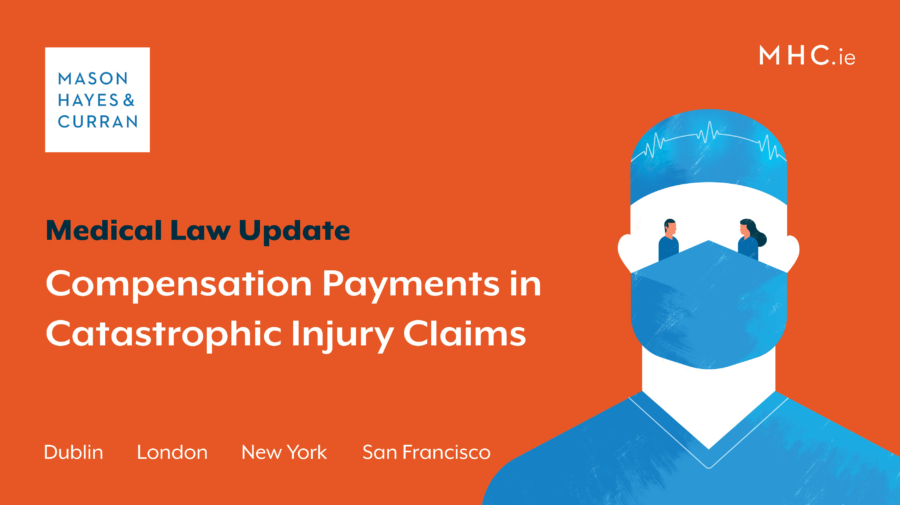
Healthcare litigation costs particularly in catastrophic injury cases continue to rise. This article reviews proposals regarding Periodic Payment Orders (PPOs) and the appropriate discount rate to be used in lump-sum settlements. Recommendations include a new indexation formula for PPOs along with regular reviews of the discount rate to maintain fair compensation levels. Our Medical Law team examines how the changes aim to provide more certainty and fairness in compensating those who suffer catastrophic injuries while addressing concerns of under-compensation.
The cost of healthcare claims in Ireland is rising. Over 50% of healthcare litigation costs annually are associated with catastrophic injury claims. The damages paid in these claims are broadly regarded as the main driver of increasing costs.
The recent working group report on the Rising Cost of Healthcare Claims made a number of recommendations for the faster and more efficient resolution of claims including:
- Resumption of the use of Periodic Payment Orders, or PPOs, by the courts, and
- Regular review of the discount rate, which is the rate of interest applied to calculate the current value of the cost of future losses
Separately, the Minister for Justice recently approved recommendations made in two working group reports from July 2024 on the indexation rate for PPOs and the discount rate. We review these recommendations.
Indexation rate working group
PPOs are an alternative to lump sum awards and are used to compensate those who have suffered catastrophic injuries. Instead of a single lump sum, payments are made annually on an agreed date to cover the cost of future care and treatment needs. PPOs have not been used since a 2019 High Court decision[1]. In that case, the Court ruled that the existing PPO legislation, which provided indexation of PPOs by reference to the Harmonised Index of Consumer Prices (HICP), would result in under-compensation of catastrophically injured persons over their lifetime.
In principle, PPOs are widely regarded as the preferred means of compensation in catastrophic injury claims. The annual payments reduce the likelihood that the injured person will run out of money to fund the cost of their future care and treatment needs. An indexation rate is applied to the annual payment amount to ensure it keeps pace with inflation.
In response to the issues with the HICP index, a working group was established to advise on the appropriate indexation rate for PPOs. The group recommended:
- In the short term, the PPO indexation rate should be based on a combination of the HICP and the annual rate of change (ARC) in nominal hourly health earnings
- The amount of a yearly periodic payment payable should be based on a PPO indexation rate comprising 80% of average ARC in nominal hourly health earnings added to 20% of the HICP, and
- The Central Statistics Office structure of earnings survey expected to start from 2026 onwards will provide wage inflation figures for the health sector. These figures should be substituted for the ARC in nominal health earnings figures when calculating the PPO indexation rate.
Discount rate working group
The discount rate is the rate of investment return used by the courts to determine the size of a lump sum award needed to fully compensate a catastrophically injured person for their future losses. The higher the discount rate, the higher the level of expected return from investment and the smaller the compensation award amount. The lower the discount rate, the lower the level of expected return and, therefore, the higher the compensation award amount.
The current discount rate as determined in Russell v HSE[2] is 1% for future care costs and 1.5% for other economic or pecuniary losses.
A working group was established to provide advice on two key elements of the discount rate:
- The assumed risk profile of the injured persons, and
- An appropriate discount rate
The group recommended:
- The discount rate should remain unchanged from the current rate.
- No change is required to the 0.5% differential allowed for wage inflation.
- Catastrophically injured persons should continue to be considered as having a risk-averse profile.
- An expert group should meet every three years at a maximum to reassess the discount rate.
- A “trigger” mechanism should be introduced to allow for any review of the discount rate, for example in the event of rapid changes to bond yields.
- Any new judgment which may supersede the Russell judgments should also trigger a review.
Working group on the rising costs of healthcare claims
The group acknowledged that the fundamental solution to reducing these costs is rooted in the prevention of clinical harm arising from unanticipated events. A number of recommendations for the faster and more efficient resolution of claims were also made. The report echoed the need for courts to have the facility to use PPOs and also the need for regular review of the discount rate.
Other recommendations included:
- Changes to the management of clinical negligence claims including:
- Introduction of pre-action protocols with sanctions for non-adherence to the protocols
- Facilitation of earlier mediation, where possible
- Amendments to case management rules to include a stipulation that equivalent rules apply to both sides
- Joint expert meetings should be required
- A dedicated court list should be established with judges in place with specialist knowledge of medical negligence litigation, or other measures to facilitate earlier hearing of cases
- A panel of medical expert witnesses who meet certain criteria should be developed and should be available to act on behalf of either party in litigation
- Medical record system with unique identifiers be put in place to facilitate better and more timely provision of medical records, including access to electronic records
Comment
Approval of the recommendations regarding PPOs is very welcome. Regulations are currently being prepared to implement these recommendations. It is hoped changes to the indexation rate will encourage catastrophically injured persons to avail of PPOs. The changes to the indexation rate should ensure payments are more closely tied to the actual costs of care and treatment over a person's lifetime providing certainty to injured persons and avoiding under-compensation. While the regulations are still awaited, there seems to be momentum for change and for PPOs to resume.
While certainty regarding the discount rate is also welcome, it is unclear how the recommendation of a ‘trigger event’ for the review of the discount rate will be dealt with in the awaited regulations. In addition, it is unknown how prescriptive the discount rate is, given that any new judgment which may supersede Russell would trigger a review.
It is hoped that the awaited regulations will lead to a revival of PPOs, which in our view are the best method of compensation in catastrophic injury cases. We await further developments in this space with interest.
For more information, contact a member of our Medical Law team.
People also ask
What are Periodic Payment Orders? |
Periodic Payment Orders are an alternative to lump sum awards as a method of paying compensation to catastrophically injured people. Instead of a singular payment, payments are made annually on an agreed date to fund the cost of future care and treatment needs. |
When is a PPO appropriate? |
PPOs would only be ordered where it is considered to be in the best interest of the injured person. The goal is to ensure the injured person does not run out of money to pay for their ongoing and future care and treatment needs. |
What is the discount rate? |
The discount rate is the rate of investment return used by the courts in cases involving catastrophic injuries. It helps determine the size of a lump sum award needed to compensate an injured persons future losses. The purpose of the discount rate is to convert an assumed future stream of income into a present lump sum. When invested, this lump sum will provide the injured person with the suitable level of compensation for their injury. The rate is expected to reflect, what a person might be expected to generate on the award amount, when invested over a period of time. This ensures that the level of compensation paid is appropriate. The higher the discount rate, the higher the level of expected return from investment and therefore the smaller the compensation award amount. The lower the discount rate, the lower the level of expected return and, therefore, the bigger the compensation award amount. It has been recommended that the rates be maintained at the same level set out in the case of Russell v Health Service Executive; 1% for future care costs; and 1.5% for other economic or pecuniary losses. |
The content of this article is provided for information purposes only and does not constitute legal or other advice.
[1] Hegarty (a minor) v HSE [2019] IEHC 788
[2] High Court [2014] IEHC 590 and Court of Appeal [2015] IECA 236
Share this:





